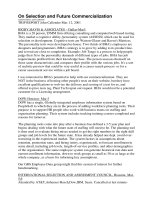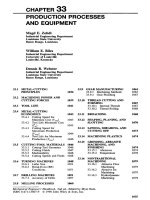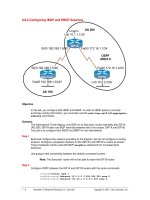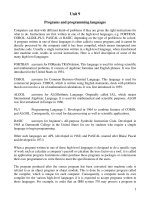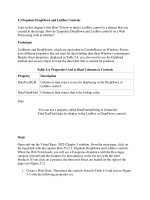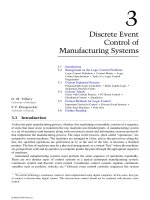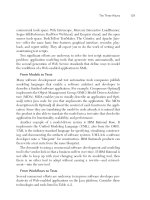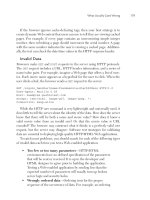Tài liệu Nutrition, Well-Being and Health Edited by Jaouad Bouayed and Torsten Bohn pdf
Bạn đang xem bản rút gọn của tài liệu. Xem và tải ngay bản đầy đủ của tài liệu tại đây (2.94 MB, 234 trang )
NUTRITION,
WELL-BEING AND HEALTH
Edited by Jaouad Bouayed and Torsten Bohn
Nutrition, Well-Being and Health
Edited by Jaouad Bouayed and Torsten Bohn
Published by InTech
Janeza Trdine 9, 51000 Rijeka, Croatia
Copyright © 2012 InTech
All chapters are Open Access distributed under the Creative Commons Attribution 3.0
license, which allows users to download, copy and build upon published articles even for
commercial purposes, as long as the author and publisher are properly credited, which
ensures maximum dissemination and a wider impact of our publications. After this work
has been published by InTech, authors have the right to republish it, in whole or part, in
any publication of which they are the author, and to make other personal use of the
work. Any republication, referencing or personal use of the work must explicitly identify
the original source.
As for readers, this license allows users to download, copy and build upon published
chapters even for commercial purposes, as long as the author and publisher are properly
credited, which ensures maximum dissemination and a wider impact of our publications.
Notice
Statements and opinions expressed in the chapters are these of the individual contributors
and not necessarily those of the editors or publisher. No responsibility is accepted for the
accuracy of information contained in the published chapters. The publisher assumes no
responsibility for any damage or injury to persons or property arising out of the use of any
materials, instructions, methods or ideas contained in the book.
Publishing Process Manager Jelena Marusic
Technical Editor Teodora Smiljanic
Cover Designer InTech Design Team
First published February, 2012
Printed in Croatia
A free online edition of this book is available at www.intechopen.com
Additional hard copies can be obtained from
Nutrition, Well-Being and Health, Edited by Jaouad Bouayed and Torsten Bohn
p. cm.
ISBN 978-953-51-0125-3
Contents
Preface VII
Chapter 1 Dietary Derived Antioxidants: Implications on Health 1
Jaouad Bouayed and Torsten Bohn
Chapter 2 Antioxidant and Pro-Oxidant Effects
of Polyphenolic Compounds and
Structure-Activity Relationship Evidence 23
Estela Guardado Yordi, Enrique Molina Pérez,
Maria João Matos and Eugenio Uriarte Villares
Chapter 3 Whole Grain Consumption and Health
of the Lower Gastrointestinal Tract:
A Focus on Insoluble-Bound Phenolic Compounds 49
Neal Okarter
Chapter 4 Nutrition and Bone Health in Old Age 73
Manuel Díaz-Curiel,
María J. Moro-Álvarez and Susana Sanz-Baena
Chapter 5 Potato Antioxidant Compounds: Impact of Cultivation
Methods and Relevance for Diet and Health 95
Danièle Evers and Hannah Deußer
Chapter 6 Beneficial Effects of Fragrances
in Beverages on Human Health 119
Hitoshi Aoshima
Chapter 7 The Therapeutic Benefits of Essential Oils 155
Abdelouaheb Djilani and Amadou Dicko
Chapter 8 Functional Foods Based on
Traditional Chinese Medicine 179
Chunyan Yao, Ruiwen Hao, Shengli Pan and Yin Wang
Chapter 9 Health-Promoting Food Ingredients
and Functional Food Processing 201
Lizhe Wang and Torsten Bohn
Preface
Nutrition is an important lifestyle factor that contributes to our general feeling well.
Recently, it has even further suggested, based on a number of epidemiological studies,
that our diet is also associated with the risk of developing a number of chronic
diseases, such as diabetes type II, cardiovascular diseases, osteoporosis, many types of
cancer, just to name few. Thus, a balanced nutrition is firmly interwoven with many
aspects of our long-term health, including the prevention of diseases, albeit this is
typically rather associated with the medicinal areas. Whereas medicine however
usually is brought on stage when a disease has already appeared, the strength of
dietary strategies would rather rest in its preventive potential.
Apart from focusing on the macro-molecules in our diet, including carbohydrates,
proteins, and lipids, a number of micronutrients such as vitamins and minerals, and
also phytochemicals (non-nutrients), or secondary plant metabolites, have moved into
the focus of attention. Among these are the most prevalent and large group of
polyphenols, the lipid soluble carotenoids, but also less well studied groups such as
terpenes. Albeit still lacking hard data in terms of randomized control, double blinded
intervention studies on large scales, there exist now a number of prospective cohort
studies that suggest that many of these phytochemicals, when consumed within e.g. a
fruit and vegetable rich diet, are important contributors to our health, and this has
been further supported by a number of studies focusing on the mechanisms of their
biological activity. In addition to some of the antioxidant properties, which have been
attributed to these compounds, additional mechanisms, such as impacting gene
transcription and therefore altering the body’s own antioxidant defense system, or
inflammatory cascades, may eventually be found to be of superior importance. Much
research is currently focusing on these topics, and more studies in this area are
warranted to reveal the potential of many of these compounds.
The knowledge that many vitamins, minerals, and phytochemicals with no direct
nutritive value are important for a healthy development is not new, but can be found
in many dietary approaches, such as in the Chinese Traditional Medicine, which aims
at closer linking specific food items for specific health conditions and diseases, i.e.
targeting to extend our common view of nutrition as merely supplying sufficient
energy and essential nutrients. Functional foods and nutraceuticals also aim toward
this direction, and many interesting approaches with potential health benefits are
VIII Preface
under consideration. Among one of these strategies are also improved technological
means, such as by increasing bioaccessibility and bioavailability of certain less stable
ingredients, by encapsulation. Only time will reveal the potential of these new
strategies to combat chronic diseases or aid in their prevention, but new possibilities in
sight of the exploding number of chronic diseases, such as the metabolic syndrome,
and the increasing age pyramid, are utterly needed.
This special issue is based on selected chapters that deal with the above mentioned
topics. Rather then aiming at giving an exhaustive overview over “Nutrition, Well-
Being and Health”, which will virtually be impossible even in a large compilation of
volumes, we chose to highlight some of the recent developments and investigations in
this domain.
We appreciate all the efforts that were bundled to bring this book together, and we
would like to express our gratitude especially toward all authors and their valuable
contributions.
Dr. Jaouad Bouayed and Dr. Torsten Bohn
Centre de Recherche Public - Gabriel Lippmann
Luxembourg
1
Dietary Derived Antioxidants:
Implications on Health
Jaouad Bouayed
1,2,*
and Torsten Bohn
1
1
Centre de Recherche Public - Gabriel Lippmann, Environment and Agro-Biotechnolgies
Department, Nutrition and Toxicology Unit, Belvaux,
2
Neurotoxicologie Alimentaire et Bioactivité, UR AFPA,
Université de Lorraine-INRA, Metz,
1
Luxembourg
2
France
1. Introduction
Oxidative stress state is involved in the aging process as well as in a vast array of
pathological conditions, including atherosclerosis, cardiovascular complications, diabetes,
cancer, and neuropsychiatric and neurodegenerative diseases. Oxidative stress is
characterized by an imbalance in the cellular redox state in favour of a high formation of
reactive oxygen species (ROS), overcoming the reducing capacity of the human antioxidant
defence system, which has the role to eliminate excess ROS production, avoiding the
oxidative action of such species on cellular components (nucleic acids, lipids, proteins or
carbohydrates) and thereby their resulting adverse effects.
In general, oxidative stress can result from a high production of ROS or a poor antioxidant
defence system, which is in part depending on exogenous molecules which could act as
antioxidants, such as vitamin C, vitamin E, carotenoids and polyphenols. ROS at low or
moderate concentrations in human tissues are required for optimum cellular functioning,
owing to their crucial role in many physiological functions, such as stimulating cellular
signaling, gene expression, the regulation of immune responses and fostering antioxidant
defense mechanisms (Valko et al., 2007; Bouayed & Bohn, 2010). While the double-edged
effects of ROS are well known, with toxic and deleterious effects at high concentrations, the
biphasic effects of antioxidants have been postulated recently (reviewed by Bouayed &
Bohn, 2010). Interaction of antioxidants with ROS present at physiological concentrations
required for optimal cell functioning could disrupt the balance between oxidant production
and antioxidant protection, being believed to be critical in maintaining healthy biological
systems. This has been earlier stressed in transgenic animals overexpressing antioxidant
enzyme systems (e.g., superoxide dismutase (SOD) and glutathione peroxidase (GPx))
(Mirochnitchenko et al., 1995; Kondo et al., 1997; Bouayed & Bohn, 2010). Exogenous
antioxidants at high concentrations could also behave as prooxidants or by activating other
cellular responses that could result in detrimental effects such as inflammatory reactions
*
Corresponding Author
Nutrition, Well-Being and Health
2
(Bouayed & Bohn, 2010). However, exogenous antioxidants at nutritional doses, as
occurring in their natural matrices such as in fruits and vegetables, are necessary to
complete the scavenging action of the endogenous antioxidant defense system. Indeed,
several laboratory, epidemiological, and intervention studies have suggested that
antioxidants from fruits and vegetables can act as chemopreventive agents against several
diseases related to oxidative stress, and are of interest especially in the prevention of chronic
diseases (reviewed by Bouayed & Bohn, 2010). The use of antioxidants (e.g. inhibitors of
xanthine oxidase) as therapeutic agents is also emerging, e.g. to treat hypertension
(reviewed by Fang et al., 2009). However, the health-promoting effects of vitamin C, vitamin
E, carotenoids and polyphenols may also occur independently from their antioxidant
properties, such as by interacting with cellular signalling pathways, interacting with e.g.
inflammatory processes or cell differentiation (reviewed by Bouayed & Bohn, 2010).
In this chapter, important classes of antioxidants occurring in our diet are presented. The
necessity of exogenous antioxidants to maintain optimal health and prevent chronic diseases
is discussed. The health-promoting effects of antioxidants within fruits and vegetables are
also emphasized. Changes occurring during and following ingestion and digestion of
bioactive compounds prior to reaching target organs and exerting their activity are also
briefly reviewed.
2. ROS and antioxidant defence system
2.1 ROS
ROS are constantly generated during normal and aberrant cell metabolism, which relies on
the use of molecular oxygen. Mitochondria constitute the principal cellular site producing
ROS, as the majority of intracellular oxygen (ca. 85%) is consumed in these organelles.
During mitochondrial respiration, high amounts of energy required for our organism are
constantly extracted from organic molecules resulting finally in complete reduction of
oxygen by 4 electrons leading to water and carbon dioxide formation. However, during
oxidative phosphorylation, 1-3% of electrons leak prematurely from the respiratory
complexes I and III of the mitochondrial electron transport chain, forming the superoxide
free radical anion (O
2
•−
), resulting from monoelectronic reduction of oxygen (Delattre et al.,
2005; Valko et al., 2007). The superoxide anion (O
2
•−
) is also generated, e.g. enzymatically by
xanthine oxidase, known for its physiologic role in purine metabolism, NAD(P)H oxidase,
especially during the oxidative burst stimulated by phagocytosis in immune cells and
cytochromes P450 involved in metabolism I phase.
O
2
•−
is considered to be the main precursor of ROS such as hydrogen peroxide (H
2
O
2
),
hydroxyl radicals (OH
•
), alkoxyl radicals (RO
•
), and peroxyradicals (ROO
•
), among others
(reviewed by Bouayed, 2010). Their order of reactivity has been determined as follows:
O
2
•−
< ROO
•
< OH
•
. Thus, the anion superoxyde radical (O
2
•−
) has a low reactivity, contrary
to the hydroxyl radical (OH
•
), which has a high reactivity, making it a very dangerous
radical with a very short half-life in vivo (Delattre et al., 2005). Indeed, when OH
•
radicals
are produced in vivo, they react close to their site of formation, explaining the non-selectivity
of OH
•
radicals toward cellular components. Other reactive species including ozone (O
3
),
peroxynitrite anions (ONOO
−
), nitrogen dioxide radicals (
•
NO
2
) and hypochlorous acid
(HOCl) could react with biomolecules without preference or specificity. Peroxyl radicals
Dietary Derived Antioxidants: Implications on Health
3
(ROO
•
) present an intermediate reactive species with respect to O
2
•−
and OH
•
radicals;
consequently ROO
•
may be more rapidly eliminated by antioxidants than O
2
•−
. The
negative electric charge of O
2
•−
impedes its diffusion across membranes, also limiting its
range of action. However, its protonated form (hydroperoxyl radical, HO
2
•
), although
constituting only ca. 0.3% of all superoxide radicals present in the cytosol of cells, is more
reactive than its precursor (O
2
•−
), and also possesses the ability to cross cellular membranes
(Delattre et al., 2005; Valko et al., 2007; Franco et al., 2009).
Despite being less reactive, the toxicity of O
2
•−
is mainly attributed to its capacity to generate
highly reactive species such as OH
•
via the Haber-Weiss reaction, or also ONOO
−
, which are
non-radical oxidizing molecules able e.g. to cause DNA fragmentation and lipid oxidation
(Fig. 1) (Delattre et al., 2005; Valko et al., 2007). ONOO
−
is the result from the reaction of O
2
•−
with nitric oxide (
•
NO), a nitrogen-centered radical and an important cellular messenger
molecule, and thus the product is considered both as an oxidant (ROS), and a nitrating agent
(reactive nitrogen species, RNS). The protonated form of ONOO
−
(peroxynitrous acid,
ONOOH), which could be easily formed at physiological pH, can decompose into OH
•
and
•
NO
2
, another RNS. However, it seems that the formation of nitrosoperoxycarbonate
(ONOOCO
2
−
) is more plausible in-vivo, following the reaction of ONOO
−
with CO
2
, due to
O
2
•–
H
2
O
2
2 H
2
O
SOD
O
2
H
2
O + ½ O
2
CAT
•
OH +
–
OH (Fenton reaction)
•
OH +
–
OH + O
2
(Haber-Weiss reaction)
H
2
O
2
C
l
–
+
H
+
H
2
O + HOCl
M
P
O
GPx
+ H
+
HO
2
•
+
•
N
O
ONOO
–
2 GSH
GSSG
NAD(P)H, H
+
NAD(P)
+
Gred
Fe
2+
or (Cu
+
)
Fe
3+
or (Cu
2+
)
-mitochondrial electron
transport chain
-xanthine oxidase
-NADP(H) oxidase
-cytochromes P450
+ 1e
-
O
2
• –
+ 2H
+
O
2
R
e
s
p
i
r
at
i
on
Fig. 1. Principal cellular pathways producing and metabolizing ROS. SOD, CAT, GPx, Gred
and MPO mean superoxide dismutase, catalase, glutathione peroxidase, glutathione
reductase and myeloperoxidase, respectively. The reaction with MPO is specific for
phagocytic cells. Fenton reaction could also involve other transition metals. GSSG and GSH
stand for oxidized and reduced glutathione, respectively. NAD(P)
+
and NAD(P)H stand for
oxidized and reduced nicotinamide adenine dinucleotide phosphate, respectively.
Nutrition, Well-Being and Health
4
the abundance of CO
2
following respiration. The decomposition of ONOOCO
2
−
results in
the formation of
•
NO
2
and carbonate radical (CO
3
•−
), a ROS (Halliwell, 2006). For the above
reason of multiple possibilities for interaction between nitrogen and oxygen containing
reactive species, many authors usually use the collective term reactive oxygen and nitrogen
species (RONS) to include both ROS and RNS. The major component of intracellular ROS in
vivo is considered H
2
O
2
, formed by its precursor O
2
•−
. Albeit being of non-radical nature,
H
2
O
2
is more reactive than O
2
•−
, having the ability to freely pass across cell membranes, and
to generate more reactive molecules such as OH
•
via e.g. the Fenton reaction, or HOCl in
phagocytic cells involving phagocyte-derived myeloperoxidase (MPO) (Fig. 1)
(Splettstoesser & Schuff-Werner, 2002; Halliwell, 2006). Due to its microbicidal activity,
HOCl (and OCl
−
) contributes to the destruction of internalized bacteria and fungi by
phagocytes (Halliwell, 2006).
2.2 Endogenous antioxidants
Cells are equipped with systems allowing for scavenging these oxidative species. This
detoxifying system or antioxidant defense system is encompassing enzymatic and non-
enzymatic antioxidants, with the latter based on endogenous (e.g. glutathione and
coenzyme Q) as well as exogenous reducers (e.g. vitamin C and polyphenols) that are
predominantly derived by dietary intake (table 1). In terms of enzymatic antioxidant
Antioxidant defense system
Endogenous antioxidants Exogenous antioxidants
Enzymatic antioxidants
- Superoxide dismutase (SOD): enzyme
detoxifying superoxide radical (O
2
•−
)
- Catalase (CAT) and glutathione
peroxidase (GPx): enzymes involved in
the detoxification of peroxides (CAT
against H
2
O
2
, and GPx against both H
2
O
2
and ROOH)
- Glutathione reductase: enzyme involved
in the regeneration of glutathione
- Thioredoxin reductase: enzyme involved
in the protection against protein oxidation
- Glucose-6-phosphate dehydrogenase:
enzyme involved in the regeneration of
NADPH
Non-enzymatic antioxidants (principal
intracellular reducing agents)
Glutathione (GSH), uric acid, lipoic acid,
NADPH, coenzyme Q, albumin, bilirubin
Prinicipal dietary antioxidants from fruits,
vegetables and grains
- Vitamins: vitamin C, vitamin E
- Trace elements : zinc, selenium
- Carotenoids: ß-carotene, lycopene, lutein,
zeaxanthin
- Phenolic acids: chlorogenic acids, gallic
acid, cafeic acid, etc
- Flavonols: quercetin*, kaempferol*,
myricetin*
- Flavanols: proanthocyanidins and
catechins
- Anthocyanidins: cyanidin* and
pelagonidin*
- Isoflavones: genistein*, daidzein* and
glycitein*
- Flavanones: naringenin*, eriodictyol* and
hesperetin*
- Flavones: luteolin* and apigenin*
* and their glucosides
Table 1. Human antioxidant defense systems include endogenous (enzymatic and non-
enzymatic) and exogenous antioxidants, with the diet being the main exogenous source
(Bouayed & Bohn, 2010)
Dietary Derived Antioxidants: Implications on Health
5
defense systems, superoxide dismutase (GPx), glutathione peroxidase (GPx) and catalase
(CAT) are the most known and prevalent antioxidant enzymes aiming to sequentially
reduce O
2
•−
and H
2
O
2
, avoiding the formation of oxidative species such as hydroxyl radicals
(
•
OH). For example, transgenic mice studies have shown the importance of antioxidative
enzymes for optimal health, even for survival. Homozygous mutant mice lacking
manganese superoxide dismutase (Mn-SOD) died within the first 10 days of life (Storey,
2004). Mice lacking the enzyme glutathione peroxidase-1 (GPx-1), which among other
functions protects the lens of the eye against H
2
O
2
-mediated oxidative damage, have
developed central cataracts (Wang et al., 2009). Homozygous catalase (CAT) knockout mice,
although apparently developing normally, have shown differential sensitivity to oxidant
tissue injury in comparison to wild-type mice (Ho et al., 2004).
SOD catalyses the dismutation of superoxide radicals (O
2
•−
) into O
2
and hydrogen peroxide
(H
2
O
2
), which is itself detoxified by either CAT or GPx to water. GPx detoxifying activity,
which extends also to peroxides (ROOH), requires glutathione (GSH) as the electron donor,
depending on glutathione reductase (Gred) that assures the regeneration of GSH from the
oxidized form (GSSG) (see Fig. 1). Glutathione transferase (GST) plays a role in the
detoxification of prooxidant xenobiotics, as well as peroxidised lipids by catalysing their
conjugation with GSH, facilitating their excretion from the cell. GSH is the most prevalent
endogenous, non-enzymatic antioxidant. GSH is considered as a major antioxidant in
aerobic cells, functioning as an important cellular redox buffer antioxidant. GSH depletion
has shown to cause systemic oxidative stress and other detrimental effects such as anxious
behaviour in mice (Bouayed et al., 2009; Bouayed, 2011). Besides its role as substrate for
GPx, GST and glyoxalase I, GSH can also directly scavenge free radicals by hydrogen
donation, resulting in glutathiyl radicals (GS
•
), following the reaction (1). However, other
reactive thiyl radicals could be generated from GS
•
such as GSO
•
and GSOO
•
(reactions (2-
3)). In addition to GSH, cells contain other endogenous antioxidants including uric acid,
lipoic acid, NADPH, coenzyme Q, albumin and bilirubin (table. 1). However, our
antioxidant defense system requires exogenous antioxidants, e.g. vitamin C, vitamin E,
polyphenols and carotenoids, to efficiently scavenge RONS acting interactively (e.g.,
additively or synergistically) in order to maintain or re-establish redox homeostasis.
GSH
+ R
•
GS
•
+ RH (1)
GS
•
+ O
2
GSO
2
•
(2)
GSO
2
•
+ GSH
GSO
•
+ GSOH (3)
2.3 Exogenous antioxidants
A compound can be defined as an antioxidant if it is able to either delay or prevent free
radical-mediated oxidation (or autooxidation) of an oxidizable compound (e.g., DNA,
proteins, lipids or carbohydrates), at low concentration compared to the substrate,
generating a more stable radical (Halliwell, 1990; Rice-Evans et al., 1996). Several dietary
compounds satisfy these two basic conditions of an antioxidant, including polyphenols and
carotenoids, and some nutrients such as vitamin C or vitamin E, of which especially fruits,
vegetables, and other plant foods such as whole grains, but also fish, meat, and dairy
products constitute natural sources (table 2).
Nutrition, Well-Being and Health
6
dietary antioxidants rich dietary sources concentration in foods
(mg/100g)
vitamin C bell pepper, citrus fruits 10-170
quercetin apples, onions 4-46
carotenoids leafy vegetables, plums,
tomatoes, watermelon, carrots
0.2-10
EGCG green tea 5-450
#
selenium
*
fish (dairy products, potato,
rice)
1-150
*
vitamin E fish, meat, leafy vegetables 0.2-10
isoflavonoids soy, beans, peanuts 0.1-155
*
g/100g;
#
mg/cup (ca. 225 mL of tea beverage)
Table 2. Examples of antioxidant concentrations in fruits and vegetables (Bouayed & Bohn,
2010)
2.3.1 Polyphenols
This group constitutes the majority of dietary antioxidants (and also of secondary plant
metabolites). Plants typically produce polyphenols as a defence against herbivores and
various stresses in general. It is estimated that in Westernized countries, polyphenol intake
is approx. 0.4-1g/d and capita (reviewed by Bouayed and Bohn, 2010), with higher intake
for persons following a vegetarian diet. Food sources that are especially rich in polyphenols
include, among others, potato, plums, leafy vegetables, whole grain products, and coffee
(Souci et al., 2000).
Several in vitro studies have shown that polyphenols are the major contributors with respect
to the total antioxidant activity of the majority of fruits and vegetables. Over 8.000
polyphenolic molecules have been identified and can be classified into flavonoids and non-
flavonoid phenolics. Certain authors consider (poly)phenols to be all secondary
phytochemicals that have at least two phenol subunits. However, (poly)phenols are also
defined as all secondary metabolites possessing an aromatic benzene ring that is substituted
by at least two hydroxyl groups, including their functional derivatives (reviewed by
Bouayed, 2010). Moreover, in the classification given by Manach et al. (2004), even phenolic
acids bearing only one hydroxyl group on the aromatic ring and acrylic acids, such as
coumaric acids, are included in the polyphenol definition.
Flavonoids have a common structure consisting of 2 aromatic rings that are linked together
by 3 carbon atoms that form an oxygenated heterocycle. This large group, which constitutes
the most prevalent in the human diet, is divided into 6 subgroups, including flavonols (e.g.
quercetin), flavones (e.g. apigenin), isoflavones (e.g. daidzein), flavanones (e.g. hesperetin),
anthocyanidins (e.g. cyanidin), and flavanols (catechins and proanthocyanidins). Non-
flavonoid polyphenolics include phenolic acids (e.g. chlorogenic acid), lignans (e.g.
secoisolariciresinol) and stilbenes (e.g. resveratrol) (Manach et al., 2004).
Polyphenols scavenge free radicals (R
•
) possessing an unpaired electron either by donation
of hydrogens or electrons, resulting in comparatively stable phenoxyl (PhO
•
) radicals
(neutral (PhO
•
) or cationic (PhO
+•
) molecules, respectively), which are stabilized by
Dietary Derived Antioxidants: Implications on Health
7
delocalization of unpaired electrons around the aromatic ring (Rice-Evans et al., 1996,
Bouayed et al., 2011a and 2011b). However, from an energetic point of view, it has been
debated that phenolics favour hydrogen atom transfer mechanisms, in which lower energies
are involved (Leopoldini et al., 2011). The radicals derived from oxygen represent the most
important class of radical species generated in living systems. However the term antioxidant
is often used to describe the scavenging activity of all reactive radicals including e.g. RNS
radicals. The potential scavenging abilities of phenolics mainly depend on the number and
the position of hydrogen donating hydroxyl groups on the aromatic cycles of the phenolic
molecules (Rice-Evans et al., 1996). For example, aglycones or polyphenols with 2 hydroxyl
groups on aromatic residues are better free radical scavengers than their glycoside forms or
polyphenols with a single hydroxyl group.
Depending on their structures, polyphenols (e.g. tea polyphenols) could also act by chelating
prooxidant transition metal ions such as Fe
2+
, which are involved in reactions eliciting free
radical production, including hydroxyl radicals (OH
•
) and alkoxyl radicals (RO
•
) (Dufresne &
Farnworth, 2001). Polyphenols that are able to scavenge lipid peroxyl (LOO
•
) and lipid alkoxyl
(LO
•
) radicals or act as singlet oxygen quenchers (
1
O
2
) are effective inhibitors of lipid
peroxidation processes, owing to the recognized role of these reactive species to initiate or to
propagate free radical lipid peroxidation in cell membranes. The polarity of polyphenols is
variable, ranging from water-soluble polyphenols (e.g. catechins), to more poorly water-
soluble (e.g. flavonoid aglycones such as quercetin), to lipophilic polyphenols (e.g. curcumin).
Many in vitro studies have clearly revealed the potent role of flavonoids in inhibiting lipid
peroxidation and oxidation of low-density lipoproteins (LDL). It has been proposed that
flavonoids near membrane surfaces are ideally located for scavenging free radicals
generated in the aqueous phase. For example, it has been debated that catechins might
prevent the oxidation of vitamin E (a lipophilic antioxidant) by scavenging hydrophilic
radicals near membrane surfaces, whereas vitamin E scavenges lipid peroxyl radicals
(LOO
•
) as hydrogen donor to stop free radical chain reactions (chain-breaking antioxidant).
Polyphenols could also play a role in the regeneration of vitamin E through reduction of its
oxidized form (vitamin E
•
radical) (Rice-Evans et al., 1996; Rice evens, 2001), acting
synergistically. In some cases, polyphenols could exert their antioxidant activity by
inhibiting the catalytic activity of many enzymes eliciting ROS formation, including
xanthine oxidase, lipoxygenase, cyclooxygenase and NAD(P)H oxidase (Atmani et al., 2009).
In food matrices, bioactivity of polyphenols like all dietary antioxidants in the human body,
depends firstly on their bioaccessibility (i.e. the release from the food matrix) and
bioavailability (i.e. absorbable fraction that can be used for specific physiological functions in
organs). Polyphenols of comparatively high bioavailability include isoflavonids (absorption
cover > 50%, Bohn, 2010), while e.g. anthocyanins are of very low bioavailability, usually ca.
1.7% (Sakakibara et al., 2009). The prerequisite for bioavailability of any compound is its
bioaccessibility in the gut. Following their ingestion, native polyphenols may undergo several
modifications in the gastrointestinal (GI) tract until absorption, changes that may also affect
their antioxidant capacity (Bouayed et al., 2011b; 2011c). This process may concern especially
polyphenols of high molecular weight such as tannins or polyphenols not absorbed in the
small intestine (e.g. polyphenols linked to a rhamnose moiety) — which could be extensively
metabolized by the microflora of the colon. In addition, the majority of polyphenols in nature
occur as glycosides or esters, which require typically cleavage prior to the absorption, such as
Nutrition, Well-Being and Health
8
by intestinal and microflora enzymes, especially cytosolic ß-glucosidase, brush border
inheritent lactase phlorizin hydrolase or esterases.
However, cellular uptake of aglycones has been suggested to occur in their native form by
passive diffusion. Absorbed polyphenols can directly undergo phase II metabolism as
phenolic structures are generally unfavorable substrates to the cytochrome P450s (phase I
metabolism). At nutritional doses, almost all polyphenols are conjugated to form O-
glucuronides, sulfate esters and O-methyl ethers, by glucuronidation, sulfation and
methylation, in the gut mucosa and later in the liver or kidney. Glucuronidation and
sulfation of polyphenols may facilitate their rapid urinary and biliary excretion by
increasing their hydrophilicity, and also may limit their potential toxicity. Bioaccessible
unabsorbed polyphenols may play a role in the protection of the GI tract against RONS
prior to their fecal excretion. In contrast to native polyphenols, less data exists on the
antioxidant activity of bioavailable polyphenol phase II metabolites (conjugated
derivatives). Despite the variable and overall relatively poor bioavailability of polyphenols
(concentrations range between high nanomolar and low micromolar in human plasma and
organs), polyphenols have been reported to be more efficient than vitamin C, vitamin E and
carotenoids (concentration ranges between high micromolar and low millimolar in human
plasma and organs) against oxidative stress at tissue levels (Scalbert et al., 2002; Manach et
al., 2004; Yang et al., 2008; Pandey & Rizvi, 2009; Bouayed & Bohn, 2010; Bouayed et al.,
2011b, 2011c).
2.3.2 Carotenoids
These tetraterpenoid (C-40) compounds are also naturally occurring substances with
antioxidant potential, and found especially in colored fruits and vegetables but also eggs,
algae, some seafood, and are synthesized by plants, bacteria and several fungi. So far, over
700 carotenoids have been identified, of which however only 40-50 species play a role in the
human diet (reviewed by Bohn, 2008). It is estimated that approx. 9-16 mg carotenoids per
day are consumed in industrialized countries (O’Neill et al. 2001). Food items rich in
carotenoids include for example spinach (11 mg/100 g edible portion), tomatoes (5 mg/100
g), and carrots (20 mg/100 g) (Biehler et al. 2011).
Some carotenoids are considered as nutrients, such as alpha-, beta-, and gamma-carotene,
and alpha- and beta-cryptoxanthin, exhibiting vitamin A activity following their
metabolisation into retinol by humans (Biehler & Bohn, 2010; Biehler et al., 2010).
Carotenoids are pigments with several conjugated double bonds (polyene chain), which
could be divided into oxygen containing carotenoids (oxocarotenoids or xanthophylls), and
non-oxygen containing carotenoids (carotenes). Despite not showing vitamin A activity,
lutein and zeaxanthin posses the ability to stabilize membrane integrity, and can efficiently
act as secondary antioxidants by absorbing damaging blue light that enters the eye (Johnson,
2002; Maci, 2010), important e.g. for the prevention of age-related macular degeneration
(Maci, 2010). These blue-light filtering phytochemicals are found especially in dark green
leafy vegetables such as spinach, broccoli and kale. However, the main mechanism of
antioxidant activity of carotenoids is radical scavenging and also quenching excited triplet
states of oxygen (
1
O
2
). Carotenoids (CAR-H) neutralize reactive radicals via electron
Dietary Derived Antioxidants: Implications on Health
9
transfer, generating carotenoid radical cations (CAR-H
•+
), which are less reactive due to the
ability of their conjugated double-bonded structure to delocalize unpaired electrons.
However, some carotenoids such as lycopene interacting with O
2
•−
may yield the carotenoid
radical anion (lycopene
•−
+ O
2
). Carotenoids (CAR-H) could also scavenge free radicals (e.g.
ROO
•
) by hydrogen atom mechanism transfer, resulting in alkyl radicals (CAR
•
). The
potential scavenging effect of carotenoids is depending mostly on the length of the electron
rich conjugated double bond system. This system can be as short as 3 double bonds in the
case of phytoene, and as long as 11 conjugated double bonds in the case of lycopene, both
two predominant carotenoids in tomato products. It has been also proposed that interaction
of carotenoids (CAR-H) with some radicals (e.g. ROO
•
) could also occur by radical addition
reaction, resulting in adduct formation (e.g. ROO-CAR-H
•
). It has been believed that
carotenoids may combine with ROO
•
to form a large resonance stabilized radical (Palace et
al., 1999; Mortensen et al., 2001; Krinsky & Yeum, 2003). It has been suggested that
carotenoids have the potential to prevent a number of degenerative diseases including
cancer, atherosclerosis and age-related macular degeneration via prevention of lipid
peroxidation (Mortensen et al., 2001), see also following chapters. Carotenoids are
hydrophobic compounds and thereby act as lipophilic antioxidants preventing
polyunsaturated fatty acids from oxidative damages. In fact, carotenoids are incorporated
into lipid membranes and thus could act as chain-breaking antioxidants by stopping free
radical chain reactions (propagation of lipid peroxidation), scavenging lipid peroxyl radicals
(LOO
•
), avoiding the abstraction of allylic hydrogens from neighboring lipids. Inactivation
of lipoxygenase activity by carotenoids is also proposed as another mechanism of protection
against oxidative stress. Although it is still controversial, it has been debated that vitamin E
regenerates the radical form of cartenoids and vice versa (Palace et al., 1999; Mortensen et
al., 2001; Splettstoesser & Schuff-Werner, 2002; Krinsky & Yeum, 2003).
It is generally admitted that carotenoids are lipid-soluble antioxidants; however we can find
exceptions of this rule with e.g. crocin, which is a water-soluble carotenoid. Differences exist
also between the xanthophylls and the carotenes – while the latter typically rests rather deep
in the apolar cores of lipid membranes, whereas the more polar oxocarotenoids interact
more with the surface of lipid bilayers (Borel et al., 1996). The beneficial role of carotenoid
consumption including the antioxidant effect of carotenoids has been questioned owing to
previous findings of several studies including results from the CARET and the Finnish
ATBC study, where comparatively high, isolated doses (supplements) of ß-carotene resulted
in increased lung cancer incidence in smokers. In fact, the general low absorption (ca. 5-20%
in most cases, Bohn, 2008), has resulted in the idea of administering high doses in rather
isolated form, such as in dietary supplements. The negative effects observed following the
administration of supplements over prolonged periods of time however have never been
related to regular dietary carotenoid consumption in healthy subjects. In contrast, several
epidemiological studies have suggested that when consumed within fruits and vegetable,
several beneficial effects can be attributed to these compounds, including reduced incidence
of cancer, cardiovascular disease, and perhaps even osteoporosis (reviewed by Bouayed and
Bohn, 2010; Bub et al., 2000). It can be hypothesized that safety and benefits of antioxidants
rely mainly on their concentration, generally physiologic (nutritional) in their natural
matrices such as within fruits and vegetables, which may explain the advantageous effects
Nutrition, Well-Being and Health
10
of phytochemicals and nutrients in plant foods, acting additively and synergistically when
consumed in a complex mixture (Bouayed and Bohn, 2010). In contrast to polyphenols,
carotenoids appear to be less extensively metabolized, and are mainly excreted via bile and
pancreas into the feces, or broken down into shorter apo-carotenals (Khachik et al.,
2002a; 2002b; 2006) and further hydroxylated, and later possibly also excreted via the urine
(Bohn, 2008).
2.3.3 Vitamin C and vitamin E
Vitamin C (ascorbic acid) is a water-soluble antioxidant, constituting one among the most
prevalent dietary antioxidants found in fruits, vegetables and beverages. Dietary intake is
usually in the area of 100 mg/d, with a DRI-RDA of 75mg/d (men) and 60mg/d (women)
(National Academy of Sciences, 2000). Food items rich in vitamin C include bell peppers (ca.
120 mg/100g) and citrus fruits such as oranges (ca. 50 mg/100g) (Souci, 2000). Vitamin C
contribution to the total antioxidant activity conferred e.g. by fruits was estimated to be
generally less than 15%, except for kiwi fruits and honeydew melons (Wang et al., 1996), as
typically, polyphenol content is up to one magnitude higher, and the antioxidant potential
as measured by several tests is about comparable (per mass) to polyphenols. Ascorbic acid
and its oxidized form, dehydroascorbic acid, both have vitamin C activity. Vitamin C is
essential for the prevention of scurvy, due to its importance as a cofactor in the
hydroxylation of proline to hydroxyproline, essential for the structure of collagen and other
tissues (Shils et al., 2006). Several advantageous effects of vitamin C on human health have
been stressed, such as the relationship between high plasma vitamin C concentration and
reduced gastric cancer risk found in EPIC study (Jenab et al., 2006). Besides the antioxidant
activity of vitamin C, which may explain its protective role against gastric cancer risk,
several other activities could play a role, such as its ability to modulate cell growth kinetics
and its putative antimicrobial activity, for example against Helicobacter pylori, a bacteria
responsible for chronic ulcer and even stomach cancer. However, in the above case–control
study, it seems that inhibition of carcinogenic N-nitroso compound formation within the
stomach is more plausible as the chemopreventive mechanism of action of vitamin C.
The relationship between dietary intake and plasma vitamin C is non-linear, with maximum
plasma vitamin C saturation (ca. 80 μmol/l) being reached with dietary intakes >1000
mg/day (Levine et al., 1996). In elderly men, a high dietary intake of both vitamin C and
vitamin E, and a higher plasma concentration of vitamin C and ß-carotene were associated
with a protection against vascular dementia and improved memory performances,
respectively (Masaki et al., 2000; Perrig et al., 1997). It has been reported that vitamin C in
plasma dose-dependently increases resistance to lipid peroxidation (reviewed by Flora,
2009). However, at elevated oral intake, vitamin C (e.g. 500 mg/day over 6 weeks) has
displayed prooxidant effects by increasing oxidative lymphocyte DNA damage of 30
healthy volunteers (Podmore et al., 1998). Furthermore, high doses can negatively impact
the intactness of the gastro-intestinal lining. In contrast, some studies on healthy human
volunteers consuming fruits and vegetables rich in vitamin C decreased levels of oxidative
DNA damage (reviewed by Halliwell, 2002). In humans, vitamin C is predominantly
present in form of ascorbate anions, and its oxidation sequentially leads first to
monodehydroascorbate (by loss of an electron) and then dehydroascorbate (by loss of
Dietary Derived Antioxidants: Implications on Health
11
hydrogen), which are relatively stable radicals, and the reaction therefore is reversible
(reviewed by André et al., 2010; Flora, 2009). The ascorbyl radical is comparatively stable
due to the stabilization of the adjacent vinyl group, transmitting electrons between the
hydroxyl and the carbonyl (Flora, 2009).
Vitamin C can be transported into the cell either as its reduced form or dehydroascorbate
(oxidized form), using active sodium-dependent transporters (SVCT1 and SVCT2) and
facilitative glucose transporters (GLUTs) (André et al., 2010). GLUTs also permit the
permeation of vitamin C into mitochondria. Besides the protective role of vitamin C against
oxidative injury within the cytosol, this water-soluble nutrient can also confer protection to
mitochondria that are targets of oxidative attacks resulting from ROS produced as a side
product of the respiratory chain that is active within mitochondria. Several beneficial
functions have been attributed to vitamin C, e.g. as regulative factors that may influence
gene expression, apoptosis and other cellular functions, and playing a role as a cofactor for
several enzymatic steps in the synthesis of monoamines, amino acids, peptide hormones,
and carnitine (Santos et al., 2009).
Besides its implication in many biological processes, vitamin C is a powerful reducing agent,
participating in several antioxidant mechanisms (Santos et al., 2009) by directly scavenging
radicals, mediating electron transfer to ascorbate-dependent peroxidases or regenerating
membrane bound vitamin E that has been oxidized, e.g. by lipid peroxyl radicals (LOO
•
),
and thus indirectly limiting lipid peroxidation in cell membranes. Radical stabilization of
the oxidized form of vitamin E (VE
•
) is conferred by electron delocalization around the
aromatic ring of vitamin E, which is a phenolic antioxidant. The dietary recommended
intake of vitamin E (DRI-RDA) is 12 mg/d (National Academy of Sciences, 2000), and main
dietary sources include vegetable oils up to 200-300 mg/kg, and to a lesser extend, leafy
vegetables and wholegrain foods (Souci, 2000). It has been considered that vitamin E is the
major membrane bound antioxidant employed in humans, and thus this lipophilic chain
breaking antioxidant has the ability to inhibit lipid peroxidation. Synergistic actions
between vitamin C and vitamin E therefore appear important in their preventive activity
against lipid peroxidation. Human trials and in-vitro studies have shown that oxidative
stress causes a rapid depletion of vitamin C and vitamin E (reviewed by Bouayed & Bohn,
2010). As mentioned above, regeneration of vitamin E may also occur by intervention of
other antioxidants such as glutathione dependent enzymes (GSH).
Eight different isomeric forms of vitamin E (4 tocopherols and 4 tocotrienols) have been
found in nature. Tocotrienols (α, β, γ and δ) are identical in structure to tocopherols except
for the degree of saturation in their side chain. However, α-tocopherol is considered to be
the most active form of vitamin E in humans. It has been found that the concentrations of
vitamin E isomers in human feces are higher than in plasma – possibly due to its limited
absorption from the diet, suggesting that it could play a protective role against RONS
produced in the GI tract (Halliwell et al., 2005). Although all vitamin E constituents can be
absorbed from the GI tract, α-tocopherol represents the predominant form existing in
human plasma with approx. 17 μmol/l, followed by γ-tocopherol at 1 μmol/l (Halliwell et
al., 2005). It has been estimated that prior to degradation, one molecule of α-tocopherol can
deactivate up to 120
1
O
2
molecules by resonance energy transfer (reviewed by André et al.,
Nutrition, Well-Being and Health
12
2010). Thus, the main antioxidant function of vitamin E is the protection of biological
membranes against oxidative damage of lipids either by quenching
1
O
2
or by intercepting
directly free radical intermediates (e.g. OH
•
, lipid radicals (L
•
), LO
•
,
LOO
•
) by hydrogen
donation generated during lipid oxidation, terminating this chain reaction of peroxidation.
Following their lipophilicity, it is more plausible that vitamin E and ß-carotene cooperate to
protect membranes and lipoproteins from oxidative damages. Of course, as all antioxidants,
vitamin E exerts other biological functions that are independent from its antioxidant
properties, including modulation of cellular signaling, gene expression, immune response,
and many more. However, as opposed to other vitamins, lack of vitamin E results in rather
unspecific symptoms, also highlighting that this vitamin is mainly needed for its antioxidant
activity in vivo. For example, deficiency of vitamin E has shown to provoke oxidative stress
disturbances in transgenic rats. In another study, vitamin E deficiency in the murine brain
caused brain oxidative stress and anxious behaviour (reviewed by Bouayed et al., 2009;
Bouayed & Bohn, 2010, Bouayed, 2011).
3. Antioxidants and disease prevention: Potential mechanisms of action
3.1 RONS and chronic diseases
When oxidative injury of cellular bio-components is not repaired by the cellular repair
mechanisms, constituting another defense system against oxidative damage, oxidative stress
can lead to several dysfunctions that would result in development and progression of
several human diseases including cardiovascular diseases (CVD), neurological diseases and
cancer, and also to the acceleration of the aging process.
DNA, proteins and lipids represent the major targets of the oxidative action of RONS. For
example, the causative link between peroxidation of lipids and lipoproteins, and several
multifactorial diseases including CVD and cancer has been stressed in several reports
(Halliwell, 2000; Atmani et al., 2009; Gupta et al., 2009; Rice-Evans, 2001). Lipid peroxidation
and protein oxidation play also a role in the progression of Alzheimer’s disease (Sultana et
al., 2006). For many diseases, endothelial changes of the blood vessels do play a role.
Peroxidation of circulating low-density lipoproteins (LDL) and especially within blood
vessel walls is thought to be a possible initiator of the pathogenesis of atherosclerosis
(Halliwell, 2000). RONS promote adhesion of platelets and monocytes to the endothelium,
resulting in endothelial lesions, and eventually thrombosis and atherogenesis (Guo & Bruno,
2011).
In addition, lipid peroxidation in liver cells could, over prolonged periods of time, lead to
liver diseases and diabetes (Atmani et al., 2009). Peroxides formed during lipid peroxidation
processes can decompose into a vast array of toxic carbonyl products such as
malondialdehyde (MDA), playing among others a role in the carcinogenesis process by
interacting with cellular DNA, yielding e.g. DNA-MDA adducts that appear to be
promutagenic (Gupta et al., 2009). The adverse effects of RONS are also involved in different
stages of carcinogenesis by causing structural DNA damage, interacting with oncogenes,
tumor suppressor genes or immunological mechanisms (Gupta et al., 2009). In this respect,
the mitochondrial DNA (mtDNA) is also a target of oxidative injury, which could lead to
lethal cell injury following mitochondrial genomic instability (Franco et al., 2009).
Dietary Derived Antioxidants: Implications on Health
13
Cumulative DNA damage over time, especially in mtDNA, plays an important role in the
aging process as well as in the pathogenesis of several acute and chronic neurodegenerative
diseases including ischemic brain injury (Fiskum, 2000; Silva et al., 2008). In addition, at the
level of mitochondria, lipid peroxidation induces the opening of the mitochondrial
permeability transition pores (MPTP), resulting in the loss of the mitochondrial membrane
potential (MMP), and subsequent impairments such as ATP synthesis, activating the
intrinsic pathway of apoptosis, and playing a significant role in neurodegeneration
following neurotrauma such as in ischemic and chronic disease-related neurodegeneration
(Fiskum, 2000, Franco et al., 2009).
Oxidative stress could also play a key role in the pathogenesis of hypertension,
counteracting the vasodilator effect of
•
NO in the vascular endothelium by favouring the
formation of peroxynitrite (ONOO
−
). It has been hypothesized that a high production of
O
2
•−
, by e.g. xanthine oxidase in the vascular endothelium leads to the rapid formation of
ONOO
−
, as the reaction between O
2
•−
and
•
NO is six-fold faster than the dismutation of O
2
•−
by SOD. In addition, the non-availability of
•
NO would stimulate the release of the
vasoconstrictor endothelin-1, and in turn, increases O
2
•−
production by activating NADPH
oxidase. As a result, the lack of
•
NO in the vascular system could result in hypertension.
Endothelial vasodilator dysfunction is related to several diseases including atherosclerosis,
coronary artery disease, ischemia, stroke, etc. (reviews: Fang et al., 2009; Guo & Bruno,
2011). On the other hand, due to oxygen-free radicals produced during normal cell
respiration, molecular and cellular oxidative damages accumulate over time, and were
hypothesized to result in aging, and ultimately death (free radical theory of aging, Harman,
1956).
3.2 Focus cancer
The advantageous effects of antioxidant properties of food ingredients (phytochemicals and
nutrients) on human health occur owing to their ability to inhibit (or retard) lipid
peroxidation (see chapter 2.2) and oxidation of other sensitive cellular bio-components,
including DNA and proteins. Several in vitro studies have shown antimutagenicity and
anticarcinogenity effects of antioxidants (e.g. tea polyphenols including catechins) at
different levels of cancer development, namely initiation, promotion and progression, albeit
these properties could also be independent from the antioxidant mechanisms. Besides the
direct protective effects of antioxidants against lipid peroxidation and DNA oxidation,
resulting in the prevention against mutations and DNA strand breakage, antioxidants (e.g.
epigallocatechin gallate (EGCG)) have the ability to inhibit the activation of procarcinogens
by phase I enzymes and also to induce detoxification of active carcinogens by phase II
enzymes, facilitating their excretion following their conjugation (Dufresne & Farnworth,
2001). Interestingly, rosmarinic acid, a dietary polyphenol, has exhibited another mechanism
of protection against oxidative DNA damages in vitro, by enhancing DNA repair resulting
from strand break formation (Silva et al., 2008).
Despite the promising in vitro chemopreventive effects of antioxidants, human
supplementation trials with individual antioxidants have generally failed to prevent CVD
and cancer formation or progression, even leading to controversial results, except in the
Nutrition, Well-Being and Health
14
Linxian trial, in which the combined effect of ß-carotene, vitamin E and various minerals
(Zn, Se) in a poorly nourished population in China has yielded beneficial effects on the
incidence on cancer in general (reviewed by Bouayed & Bohn, 2010). In contrast, earlier
retrospective epidemiological studies have suggested preventive effects of colored fruits and
vegetables rich in carotenoids, high ß-carotene plasma concentrations against cancer risk,
especially lung cancer. Epidemiologists have also presented fruits and vegetables rich in
polyphenols including e.g. apples, onion and white grapefruit as protective strategies
against lung cancer (reviewed by Bouayed & Bohn, 2010). Although it is thought that
anticarcinogenity of these food plant items was related to the entire effects of all ingredients
of fruits and vegetables (e.g. vitamins, polyphenols, carotenoids, dietary fiber and many
more) acting additively and synergistically, and unfolding several protective mechanisms;
many researchers have aimed to attribute the advantageous effects of these plant foods to
few or even individual components, such as ß-carotene and quercetin, owing to their
antioxidant properties including the chemopreventive activity of quercetin against
carcinogens in vitro (reviewed by Bouayed & Bohn, 2010). Nevertheless, due to the many
confounding factors, it is generally extremely difficult to attribute the observed beneficial
health effects to specific ingredients. Moreover, it cannot be excluded that the so far targeted
phytochemicals, including carotenoids and polyphenols, are merely indicators for a fruit
and vegetable rich diet, or that they are indicative of additional, yet unidentified beneficial
health compounds.
Thus, although a high intake of fruits and vegetables is believed to be a good way to prevent
against cancer and other chronic diseases, recent prospective epidemiological studies such
as the EPIC study have shed some doubt at the strength of this relationship, at least for
certain types of cancers such as lung, breast and prostate cancers (reviewed by Key, 2011).
However, several case–control studies and few prospective cohort studies have shown an
inverse relationship between high fruits and vegetables intake and the risk of several types
of cancers including cancers of the oral cavity, pharynx, larynx, oesophagus and stomach
(reviewed by Key, 2011). In addition, based on an observational study on Korean dietary
habits, showing that “westernization” of diet (i.e. high intake of calories and fats and limited
intake of plant foods) has led to a rapid increase of mortality due to several types of cancers
including lung (by 53%), breast (by 37%), pancreas (by 63%), prostate (by 200%) and colon
(by 75%) cancers within one decade (1990-1999). These cancers were less often fatal when
plant-based diets were adopted, thus highlighting the preventive effect of plant foods
against cancer development (Lee et al., 2004, review).
3.3 Focus CVD
In addition to cancer, the advantageous effects of antioxidants are also recognized in the
prevention of several other human chronic diseases, such as coronary heart disease (CHD)
and stroke. Prospective cohort studies showed that the inverse relationship between the
potential of prevention of fruits and vegetables against the above diseases depended on the
amount of edible portions consumed per day. The protection against coronary heart disease
was generally established when fruits and vegetables were consumed at >4 servings/d for
several years often >8 years. In a meta-analysis of eight independent cohort prospective
studies, it has been shown that consumption of >5 servings/d of fruits and vegetables
Dietary Derived Antioxidants: Implications on Health
15
caused a stronger reduction in stroke (ischaemic and haemorrhagic stroke) compared to 3–5
servings, the latter consumption reducing stroke incidence significantly compared to <3
servings/d. A recommended portion is somewhat vaguely defined as 80–100 g (reviewed by
Bouayed & Bohn, 2010).
In the world, certain dietary regimens are assumed to be healthier, providing high amounts
of nutrients (vitamins, minerals) and non-nutrients (dietary fiber, carotenoids, polyphenols,
monounsaturated fatty acids, etc), preventing the development (or the progression) of
several human chronic diseases at epidemic level in several populations. For example,
traditional Mediterranean regimens are based on diversity and high intake of plant-based
foods such as olive oil, cereals, legumes, nuts and vegetables and also other food items such
as honey, eggs and fish. Thus, moderate energy intake and limited animal fat are the
landmarks of this regimen.
Several benefits have been attributed to Mediterranean diets, among them their ability to
reduce several forms of cancer, cardiovascular diseases and related mortality (Psaltopoulou
et al., 2004; Scarmeas et al., 2006; Lairon, 2007; Mekki et al., 2010; Fung et al., 2010). In this
respect, a Greek prospective study has shown a negative relationship between
Mediterranean regimen and hypertension (Psaltopoulou et al., 2004), which is an important
precursor of other diseases such as renal insufficiency, stroke and especially several
cardiovascular complications including atherosclerosis, myocardial infarction, congestive
heart failure, peripheral vascular disease and sudden cardiac death. It has also been verified
prospectively that a Mediterranean diet could reduce the risk of Alzheimer's disease
(Scarmeas et al., 2006). In addition, dietary intervention studies have shown that the
adoption of a Mediterranean diet reduced several cardiovascular risk factors in subjects at
risk (primary prevention), and/or reduced cardiovascular events/mortality in patients
following a first cardiac event (secondary prevention) (Reviewed by Lairon, 2007). It has
also been recommended that the Mediterranean diet could improve dyslipidemia and
prevent against lipid peroxidation and inflammation in chronic renal failure patients (Mekki
et al., 2010).
Vegetarian diets could also be a good example to review the health-promoting effects of
plant food ingredients. Comparisons between vegetarians and non-vegetarians (omnivores)
have shown that vegetarians have in general, lower risk of mortality from ischemic heart
disease, hypertension, stroke, type 2 diabetes and certain cancers. Differences have also been
noticed regarding body mass index, total serum LDL levels, and blood pressure. However,
it seems that persons following a vegetarian regimen, especially vegans, possibly will need
to include some fortified foods or supplements, providing e.g. vitamin D, vitamin B
12
, ω-3
fatty acids, iron, calcium, zinc and iodine, to equilibrate their diet and to maintain optimal
health (reviewed by Fang et al., 2009).
The use of antioxidants as antihypertensive agents in both preventive and therapeutic
approaches is also emerging. The inhibition of vascular endothelial xanthine oxidase may
result in antihypertensive effects favouring NO-induced vasorelaxation. It has been shown
that i.v. injection of 4-amino-6-hydroxypyrazolo[3,4-d]pyrimidine, a synthetic xanthine
oxidase inhibitor, reduced the blood pressure of hypertensive rats to 70% of the initial blood
pressure (review: Fang et al., 2009). Several natural antioxidants, e.g. some polyphenols
